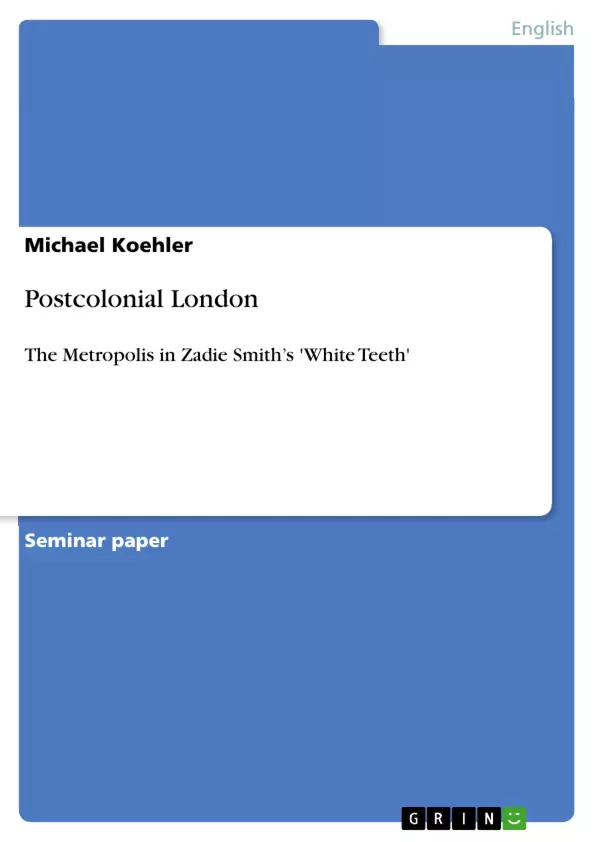Zadie Smith’s novel "White Teeth" deals with families and generations from diverse ethnic backgrounds; and in the four main chapters Archie 1974, 1945, Samad 1984, 1857, Irie 1990, 1907, and Magid, Millat and Marcus 1992, 1999, she approaches them from several angles. As a result, there has been a discussion on who is to be treated as the central character in this novel. One possible answer to this is offered by Nina Shen Rastogi:
The main character in White Teeth isn’t a character in any traditional sense – it’s the city of London itself. Smith’s goal is less to paint a portrait of any particular character than it is to create a large-scale character sketch of a particular place and a particular time. White Teeth is about the foibles of a community of near-strangers and almost-friends as it collectively stumbles towards an uncertain future.
The paper will investigate this approach by dealing with London as it is depicted in this postcolonial novel.
After a working definition on the diversely discussed notion of postcolonialism (I.1), there will be a closer look on London, both as a physical location (I.2.a) and a literary region (I.2.b). The main issues will be the history of immigration, facts about multiculturalism today, and a brief look on how the colonial legacy has been depicted in postcolonial literature in London. A conclusion (I.3) will summarize the results and present some main questions for the analysis of White Teeth (II).
Here, the paper will take a look on the role of the characters interacting with each other and on how they compromise between their cultural legacy and London’s society (II.1). This will be the major part of the analysis. In two short chapters, this view will be extended by the use of location (II.2) and language (II.3).
The conclusion finally tries to sum up the main aspects gathered in this line of argument.
Inhaltsverzeichnis (Table of Contents)
- Introduction
- I. Postcolonial London
- 1. Postcolonialism
- 2. London
- a) London as a Physical Location
- b) London as an Imagined Place
- 3. Conclusion
- II. London in Zadie Smith's White Teeth
- 1. Characters
- a) Caribbean
- b) Bangladeshi
- c) White British
- d) Conclusion
- 2. Locations
- 3. Language
- Conclusion
- 1. Characters
- Bibliography
Zielsetzung und Themenschwerpunkte (Objectives and Key Themes)
This paper examines the portrayal of London in Zadie Smith's novel White Teeth as a postcolonial city. It aims to understand how London's physical and imagined landscapes are shaped by the legacy of colonialism and immigration. By analyzing the novel's characters, locations, and language, the paper aims to explore the complexities of multiculturalism and identity in contemporary London.
- Postcolonialism and its impact on London
- The role of immigration in shaping London's physical and social landscape
- The representation of different ethnic groups and their interactions in White Teeth
- The relationship between culture, identity, and place in postcolonial London
- The use of language as a tool for expressing cultural differences and navigating multicultural spaces
Zusammenfassung der Kapitel (Chapter Summaries)
The paper begins by defining postcolonialism and discussing its relevance to London. It explores London as a physical location, examining its history of immigration and the impact of colonial legacies on its multicultural landscape. Additionally, it considers London as an imagined place, highlighting how artistic representations of the city have been influenced by postcolonial writers and artists.
The analysis then shifts to White Teeth, focusing on the characters' interactions and the complexities of their cultural identities within the context of London. The paper examines the different ethnic groups portrayed in the novel, their experiences of navigating multicultural London, and their attempts to reconcile their cultural legacies with their present realities. It also briefly explores the use of locations and language to convey the diverse experiences of London's multicultural population.
Schlüsselwörter (Keywords)
This paper explores the key concepts of postcolonialism, multiculturalism, and identity as they relate to the city of London in the context of Zadie Smith's novel White Teeth. It examines the influence of colonialism, immigration, and cultural diversity on London's physical and imagined landscapes, focusing on themes such as race, class, and language.
- Quote paper
- Michael Koehler (Author), 2006, Postcolonial London, Munich, GRIN Verlag, https://www.grin.com/document/132015



